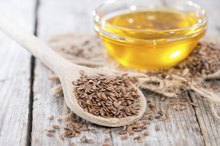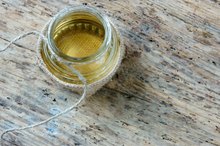Is a Cholesterol Level of 158 LDL High?
Approximately 17 percent of adult Americans have high cholesterol, reports the Centers for Disease Control and Prevention. If you are among them, you face a greater risk of heart disease, heart attack and stroke than those with healthy cholesterol levels. Your low-density lipoprotein, LDL cholesterol, increases your risk of these conditions the most; knowing the difference between healthy and unhealthy levels offers a better line of defense for your heart.
Healthy LDL Cholesterol
Your LDL cholesterol levels have five categories: optimal, near optimal, borderline high, high and very high. A measurement of 130 to 159 milligrams per deciliter places you in the range of borderline high, an area which may pose a health risk depending on the number of risk factors you have for heart disease aside from your cholesterol level. Your doctor takes all of this into consideration before determining how to treat your condition.
Risk Factors
Can Your Cholesterol Level Make You Feel Tired?
Learn More
In addition to high cholesterol, being obese, living an inactive lifestyle and smoking increase your risk for developing heart disease. Family history of heart disease is another factor, along with medical conditions such as diabetes and high blood pressure.
Determining Treatment
Although a LDL level of 158 milligrams per deciliter is borderline high, this may be more dangerous to some people than to others. In most cases, your doctor chooses to treat with dietary and lifestyle changes first. If you have heart disease and a LDL level of 130 milligrams per deciliter or higher, treatment with medication may be necessary even after lifestyle changes. Medication is usually an option if you have two or more risk factors for heart disease along with a cholesterol level of 160 milligrams per deciliter or more, according to the American Heart Association.
- Although a LDL level of 158 milligrams per deciliter is borderline high, this may be more dangerous to some people than to others.
- If you have heart disease and a LDL level of 130 milligrams per deciliter or higher, treatment with medication may be necessary even after lifestyle changes.
Dietary and Lifestyle Changes
Hemp Seed Oil vs. Flaxseed Oil
Learn More
Dietary and lifestyle changes include losing weight, eating fewer saturated and trans fats and increasing your dietary fiber. Obesity is a common risk factor for high cholesterol; one usually accompanies the other. Enlist the help of a dietitian to ensure the healthiest eating plan possible. Saturated fats, such as red meat, whole fat dairy products, egg yolks and vegetable oil negatively affect your LDL cholesterol. Limit your intake to less than 7 percent of your daily calories, recommends the Cleveland Clinic. Trans fats are found in baked goods and snack foods. These are worse for you than saturated fats and should be eliminated completely. High fiber foods such as oats, vegetables, fruits, lentils, legumes and whole grains help to lower your LDL by absorbing it in your intestines and flushing it from your body. Increasing the amount of exercise you get each day lowers your cholesterol and strengthens your heart. Participate in a minimum of 30 minutes each day.
- Dietary and lifestyle changes include losing weight, eating fewer saturated and trans fats and increasing your dietary fiber.
- High fiber foods such as oats, vegetables, fruits, lentils, legumes and whole grains help to lower your LDL by absorbing it in your intestines and flushing it from your body.
Statins
Doctors commonly prescribe statins to lower your LDL cholesterol. The National Heart Lung and Blood Institute explains that patients, on average, lower their cholesterol 20 to 60 percent when taking these drugs. It typically takes four to six weeks for these medications to take full effect. Your doctor may add a bile acid sequestrant to increase the effectiveness of your statin. These two drugs combined can result in a more than 40 percent decrease of your LDL.
- Doctors commonly prescribe statins to lower your LDL cholesterol.
- These two drugs combined can result in a more than 40 percent decrease of your LDL.
Related Articles
References
- American Heart Association: What Your Cholesterol Levels Mean
- Cleveland Clinic: Nutrition: Cholesterol Guidelines
- American Heart Association: Cholesterol-Lowering Drugs
- American Academy of Family Physicians. High cholesterol. Updated December 5, 2019.
- MedlinePlus. High blood cholesterol levels. Updated February 22, 2018.
- Harvard Health Publishing. How it's made: cholesterol production in the body. Updated July 31, 2019.
- MedlinePlus. Cholesterol levels: what you need to know. Updated April 18, 2019.
- Lepor NE, Vogel RE. Summary of the third report of the National Cholesterol Education Program Adult Treatment Panel III. Rev Cardiovasc Med. 2001;2(3):160-5. doi:10.1001/jama.285.19.2486
- Familial Hypercholestrolemia Foundation. Surprising familial hypercholestrolemia statistics. Updated March 6, 2015.
- Cleveland Clinic. LDL cholesterol and heart health. Updated May 24, 2019.
- Harvard Health Publishing. 11 foods that lower cholesterol. Updated February 6, 2019.
- American Heart Association. Cholesterol medications. Updated November 10, 2018.
- American Heart Association. Prevention and treatment of high cholesterol (hyperlipidemia). Updated April 13, 2017.
- Centers for Disease Control and Prevention. Heart disease. National Center for Health Statistics. Updated February 21, 2020.
- National Heart, Lung, and Blood Institute. High blood cholesterol: What you need to know." Updated June 2005.
- Fallon Jr., L. Fleming. "Hypercholesterolemia." Health AtoZ, Gale Encyclopedia of Medicine. 2006. The Gale Group.
Writer Bio
Based in Jamestown, Pa., Hannah Rice Myers has more than 10 years of experience as a freelance writer, specializing in the health industry. Many of her articles have appeared in newspapers, as well as "Curing Epilepsy: Hope Through Research." Rice Myers received her master's degree in nursing from Upstate Medical University in 2001.









